


















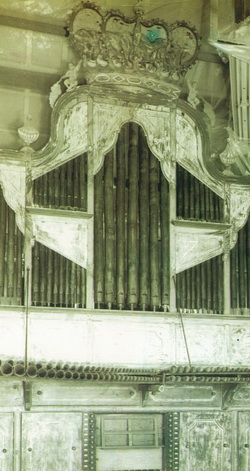
Las Piñas was once a fishing barrio of Parañaque. In 1762, upon the request of the Augustinians, the barrio was recognized as a town with 1,200 residents, mostly involved in farming, fishing, and salt-making. However, Las Piñas was unable to sustain its own parish and still remained under the watch of the parish priest of Parañaque, Fr. Gregorio Giner. It was in August 1775 when the spiritual administrationof the town was turned over to the Agustinian Recollects, with Fr. Nazario de Ayala as its first parish priest. They were not to receive any support from the government unless they meet the minimum requirement of having 500 tax-paying residents. At that time, there were only 300 taxpayers in Las Piñas.
Two decades after the Augustinians took over the parish, Fr. Diego Cera was appointed parish priest. Upon his arrival in Las Piñas, all that Fr. Cera saw was a small chapel made of bamboo and nipa. Together with the residents, he dreamed of a church made of stone. In 1800, the building of the stone edifice began, with townspeople rendering construction services in exchange for food. The church, in what is described as “earthquake Baroque” architecture, was completed in 1819.
It had three naves, a dome, side altars, crypt sones each with a replica of the “Nuestra Señora dela Consolacion” on one side and St. Augustine on the other, a baptistry with a stone altar, and two sacristies.
The church underwent a major restoration, which was completed in December 1972, under the care of Architect Bobby Mañosa.
While the stone church was still under construction, Fr. Diego Cera prepared to build a pipe organ that would fill the church with religious music. In 1816, he gathered bamboo poles and burden these under the beach sand. Bamboo was abundant in the area and burying the poles was a natural way of protecting it from attacks of pests as well as for preservation. After a year, he unearthed the bamboo poles, and with the help of some residents whom he had earlier trained, Fr. Cera began building the organ.
Musicologist Helen Samson writes in her book The Bamboo Organ of Las Piñas that Fr. Cera at first attempted to use bamboo for one hundred and twenty two trumpet pipes. This experiment proved unsatisfactory so the bamboo trumpets were replaced later by pieces made of metal. The initial bamboo trumpets came to be relegated as “blind” or purely ornamental pipes and placed at the rear.
The bamboo organ is composed of 832 bamboo tubes and 122 horizontally placed metal pipes. It has 23 stops and measures 5.17 meters tall, 4.11 meters wide, with a depth of 1.45 meters. Wind pressure for the bamboo organ is supplied by the billows, which, during Fr. Cera’s time, required the steady cooperation of six persons working in shifts each time the organ is played. A steady wind supply is necessary for the proper maintenance of pitch – too little pressure would cause the pitch to go down, while too much would make the pitch higher.
The bamboo organ was completed in 1824 and filled the church with heavenly music for thirty eight years. According to church records, the instrument “was the finest and the first of its kind in the country and even in the whole world because of the materials used in its construction.”
Unfortunately, three earthquakes in July 1880 wrought major damage to the bamboo organ. And a devastating typhoon in October 1882 totally wrecked it, with many of its parts taken adrift in the floodwaters.
Initial effort to restore the organ came in 1960 when the German government offered to cover the cost of restoration, provided it was done in Germany. Various concerns, including the safe transport of the organ parts, put the restoration project on hold. A decade later, the parish priest, Fr. Mark Lesage, C.IC.M. and his assistant, Fr. Leo Renier who was an organist, led the move to restore the bamboo organ.
In 1973, two technicians from the Klais firm, arrived in Las Piñas to dismantle the bamboo organ. On February 18, 1975, the Las Piñas Bamboo Organ was brought back to life and a celebration ensued with a concert at the Philippine Embassy in Bonn with eminent organist Wolfang Oehms. The organ made its homecoming on March 13, 1975.

To celebrate the return of the Bamboo Organ to its home, an inaugural concert was held featuring Wolfang Oehms, Lucrecia Kasilag (who was eventually named National Artist), the Las Piñas Boys’ Choir, Maharlika Rondalla, and the Cutlural Center of the Philippines Orchestra.
Since then, an annual International Bamboo Organ Festival has been held every third week of February, attracting musicians and music enthusiasts from all over the Philippines and the world. The Festival is now on its 36th year, and Villar SIPAG has been a sustaining patron. Villar SIPAG hosts a Filipino-themed cocktail after the gala performances.
References: Crisanto, Joyce M. & Chit dela Torre. Las Piñas: A City with Heritage. Las Piñas City, Philippines: Villar SIPAG, 2006.
Romanillos, Emmanuel Lus A. Bishop Ezekiel Moreno: An Augustian Recollect Saing Among Filipinos. Quezon City, Philippines: Agustino Recoletos, Province of Saint Nicholas Tolentino, Vicariate of the Philippines and China; 1993.
Samson, Helen. The Bamboo Organ of Las Piñas. Las Piñas City: The Bamboo Organ Foundation, 2006.
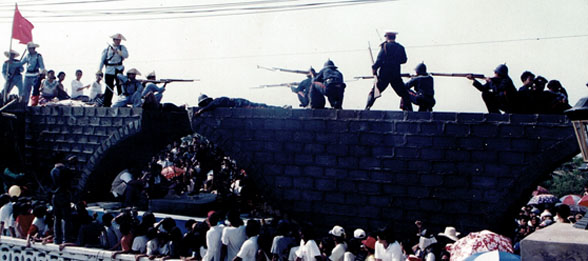
The Battle of Zapote Bridge was fought on Febraury 16, 1897 between 3,000m Americans and 5,000 Filipinos. It was the second largest battle during the Philippine-American War.
General Edilberto Evangelista is a prominent figure in this battle. A Belgian-trained engineer, he taught the Katipuneros how to build trenches, batteries and pillboxes. His designs were instrumental in a number of Filipino victories around the Cavite province.
Zapote River separates the City of Las Piñas in Metro Manila from Bacoor in the Province of Cavite. The original Zapote Bridge was hit during the battle, causing one-half to collapse. The office of Congresswoman Villar funded the restoration of the half of the bridge, to become a pedestrian promenade, which connects Barangay Zapote, Las Piñas to Barangay Zapote in Bacoor, Cavite. Monument parks were established on both ends of the bridge: through Congresswoman Villar’s intercession, the Basa family allowed the erection of a monument by sculptor Ed Castrillo on their property in the Las Piñas side; while a monument depicting the Battle of Zapote Bridge was established in Bacoor by the Philippine Tourism Authority under the leadership of then General Manager Barbers, upon the request of Senator Manny Villar, who also funded the rehabilitation of the barangay hall to follow 18th century architecture.
In February 1997, on the centenary of the historic battle, the Villar SIPAG coordinated with the local governments of Bacoor, Cavite and the City of Las Piñas, the National Centennial Movement and the Department of Education in order to orchestrate the celebration, which included a parade and a street drama based on the events of 1896-1897 highlighted by the reenactment of the Battle of Zapote Bridge. Participants and guests came dressed in turn-of-the-century regalia.

Reference:
Crisanto, Joyce M. & Chit dela Torre. Las Piñas: A City with Heritage. Las Piñas City, Philippines: Villar SIPAG, 2006.

The Molino Dam’s construction has been traced between the late 18th to the early 19th century. Built by hand, the dam served the irrigation needs of the rice fields in Las Piñas and the nearby towns of Cavite. The long-drawn-out drought in 1885 moved the parish curate, Fr. Ezekiel Moreno, to request for the rehabilitation of the dam wall answer the need for food of many residents.
Rice fields can no longer be found in Las Piñas and Cavite, but the Molino Dam stands as a historic testament to the engineering prowess of 18th and 19th century residents of Las Piñas, and to serve as a recreation area and tourist attraction.
References: Crisanto, Joyce M. & Chit dela Torre. Las Piñas: A City with Heritage. Las Piñas City, Philippines: Villar SIPAG, 2006.
Romanillos, Emmanuel Lus A. Bishop Ezekiel Moreno: An Augustian Recollect Saing Among Filipinos. Quezon City, Philippines: Agustino Recoletos, Province of Saint Nicholas Tolentino, Vicariate of the Philippines and China; 1993.
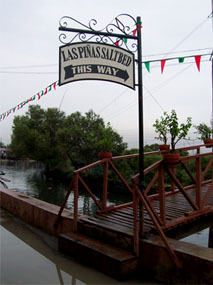
Las Piñas was one of the earliest settlements on the fringes of Manila, which explains its colorful past that dates
back to the 17th century. It used to be a barrio of Parañaque, then a sleepy fishing village with only 1,200 residents.
For the early Las Piñeros, the main means of livelihood were salt-making, fishing, sea shell picking and planting
rice. The community was headed by cabezas de barangay, a westernization of the local chieftains and the
principalia as the local aristocrats were called, a very durable social institution since they were the political
absorbers.
Later simple industries like dye-making, salt-production and handicrafts began to develop in the old town.
On March 27, 1907, Las Piñas was proclaimed an independent municipality by virtue of Philippine Commission
Act No. 1625.
By the 1960s, with the construction of the South Superhighway, Las Piñas became a first class municipality. Las
Piñas’ geographic proximity to Manila and its transportation became a major attraction to real estate developers
and business investors, eventually transforming this once-quiet and rustic coastal town into a booming urban
center of residential subdivisions and large industries.
The Coastal Road or the Manila-Cavite Expressway is a radial road that runs up to 6.6 kilometers and connects
Las Piñas and the province of Cavite to Roxas Boulevard in Manila and Seaside Drive in Paranaque. Its
construction in the 1970’s brought about displacement to salt makers and fishermen of Las PIñas.
But even until now, some Las Piñeros from barangays E. Aldana, Pulang-lupa 1 and Daniel Fajardo are fisher
folks planting and harvesting mussels and clams as a means of livelihood. In their behalf, a fish port was
constructed in Bernabe Compound, Pulang lupa 1 to help them in their livelihood.
Las Piñas was officially included as one of the towns and cities comprising the then Metro Manila area
(now National Capital Region) in 1976.
In recognition of its rapid urbanization and steady growth, Congress passed a bill authored by former Las Piñas
Congressman Manuel B. Villar Jr. converting the municipality into a highly-urbanized city.
On February 12, 1997, President Fidel V. Ramos signed the Las Piñas cityhood bill into law. Residents approved
their cityhood in a plebiscite on March 26, 1997, making Las Piñas the 10th city of Metro Manila.
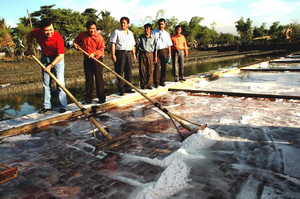
References: Crisanto, Joyce M. & Chit dela Torre. Las Piñas: A City with Heritage. Las Piñas City, Philippines: Villar SIPAG, 2006. Villar, Cynthia A. My Journey in the Las Piñas Arts & Crafts Industry. Las Piñas City: Villar SIPAG, 2008.



Las Piñas was one of the earliest settlements on the fringes of Manila, which explains its colorful past that dates
back to the 17th century. It used to be a barrio of Parañaque, then a sleepy fishing village with only 1,200 residents.
For the early Las Piñeros, the main means of livelihood were salt-making, fishing, sea shell picking and planting
rice. The community was headed by cabezas de barangay, a westernization of the local chieftains and the
principalia as the local aristocrats were called, a very durable social institution since they were the political
absorbers.
Later simple industries like dye-making, salt-production and handicrafts began to develop in the old town.
On March 27, 1907, Las Piñas was proclaimed an independent municipality by virtue of Philippine Commission
Act No. 1625.
By the 1960s, with the construction of the South Superhighway, Las Piñas became a first class municipality. Las
Piñas’ geographic proximity to Manila and its transportation became a major attraction to real estate developers
and business investors, eventually transforming this once-quiet and rustic coastal town into a booming urban
center of residential subdivisions and large industries.
The Coastal Road or the Manila-Cavite Expressway is a radial road that runs up to 6.6 kilometers and connects
Las Piñas and the province of Cavite to Roxas Boulevard in Manila and Seaside Drive in Paranaque. Its
construction in the 1970’s brought about displacement to salt makers and fishermen of Las PIñas.
But even until now, some Las Piñeros from barangays E. Aldana, Pulang-lupa 1 and Daniel Fajardo are fisher
folks planting and harvesting mussels and clams as a means of livelihood. In their behalf, a fish port was
constructed in Bernabe Compound, Pulang lupa 1 to help them in their livelihood.
Las Piñas was officially included as one of the towns and cities comprising the then Metro Manila area
(now National Capital Region) in 1976.
In recognition of its rapid urbanization and steady growth, Congress passed a bill authored by former Las Piñas
Congressman Manuel B. Villar Jr. converting the municipality into a highly-urbanized city.
On February 12, 1997, President Fidel V. Ramos signed the Las Piñas cityhood bill into law. Residents approved
their cityhood in a plebiscite on March 26, 1997, making Las Piñas the 10th city of Metro Manila.


Las Piñas used to dominate the parol (Christmas lantern) industry with its traditional parols – with frames made of bamboo strips and covered with Japanese paper. Competition brought about by cheaper materials caused the decline of the industry.
In 2007, encouraged by Congresswoman Cynthia Villar, the magpaparols (parol makers) organized themselves into the Samahang Magpaparol ng Las Piñas. To support them, Congresswoman Villar set-up the Las Piñas Parol Center. The Center serves as a training area and where new designs and packaging techniques are explored together with technical people sent by the Department of Trade and Industry.
Since then, the Villar SIPAG has sponsored an annual Parol Festival showcasing the craftsmanship of the Las Piñas magpaparols and celebrating this tradition with singing and dancing.
A Parol Making Competition is held featuring the use of various materials ranging from natural (grass, leaves, etc.) to recyclable items (plastic bottles, used tin cans, etc.).

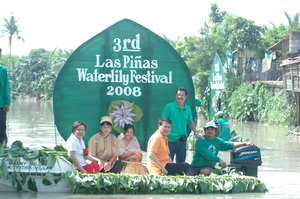

The Water Hyacinth Weaving Enterprise, which provides livelihood to over 200 families, was set up by Villar SIPAG and is given a boost during the day-long “Water Lily” Festival in July. The water hyacinths bear lily-like flowers, which has moved locals to call it water lily.
To clear the Las Piñas River of this aquatic pest, residents harvest them and dry the stalks, which become the raw material for producing baskets, trays, slippers, and other functional and ornamental items. The Festival features demonstrations on basket weaving, variety shows participated in by home-grown talents, trade fair featuring products made from water hyacinths as well as other products from the various barangay livelihood projects.
